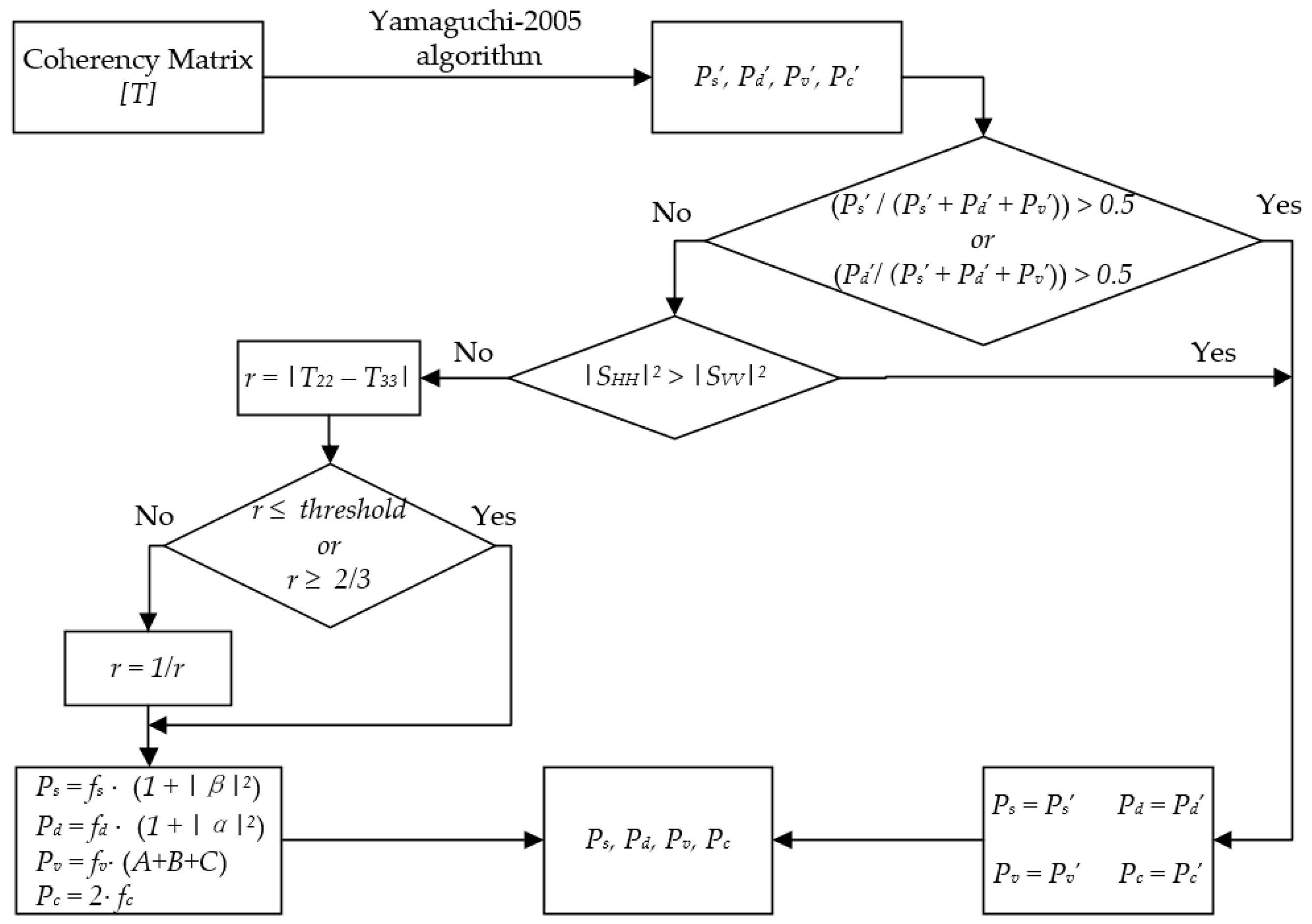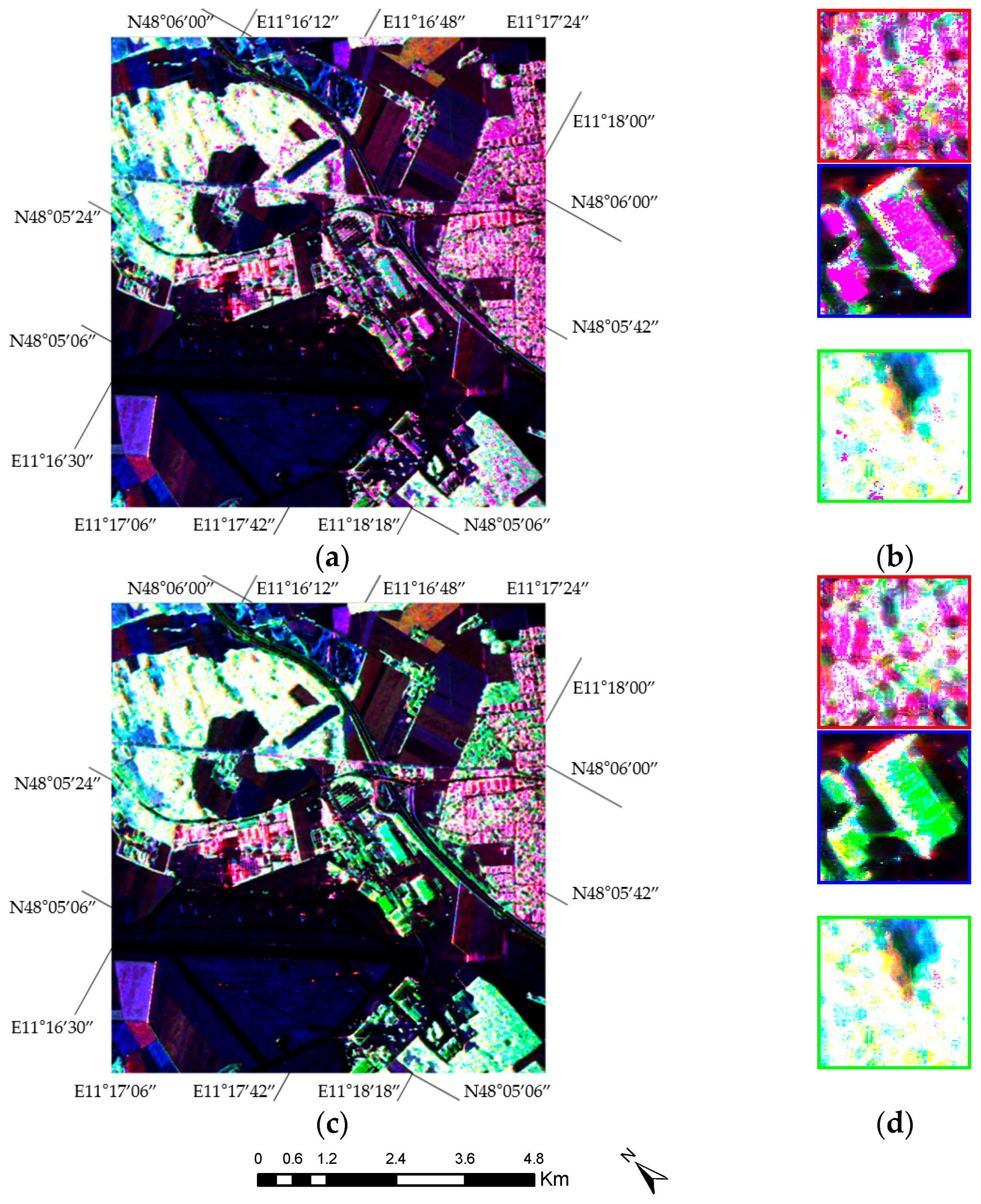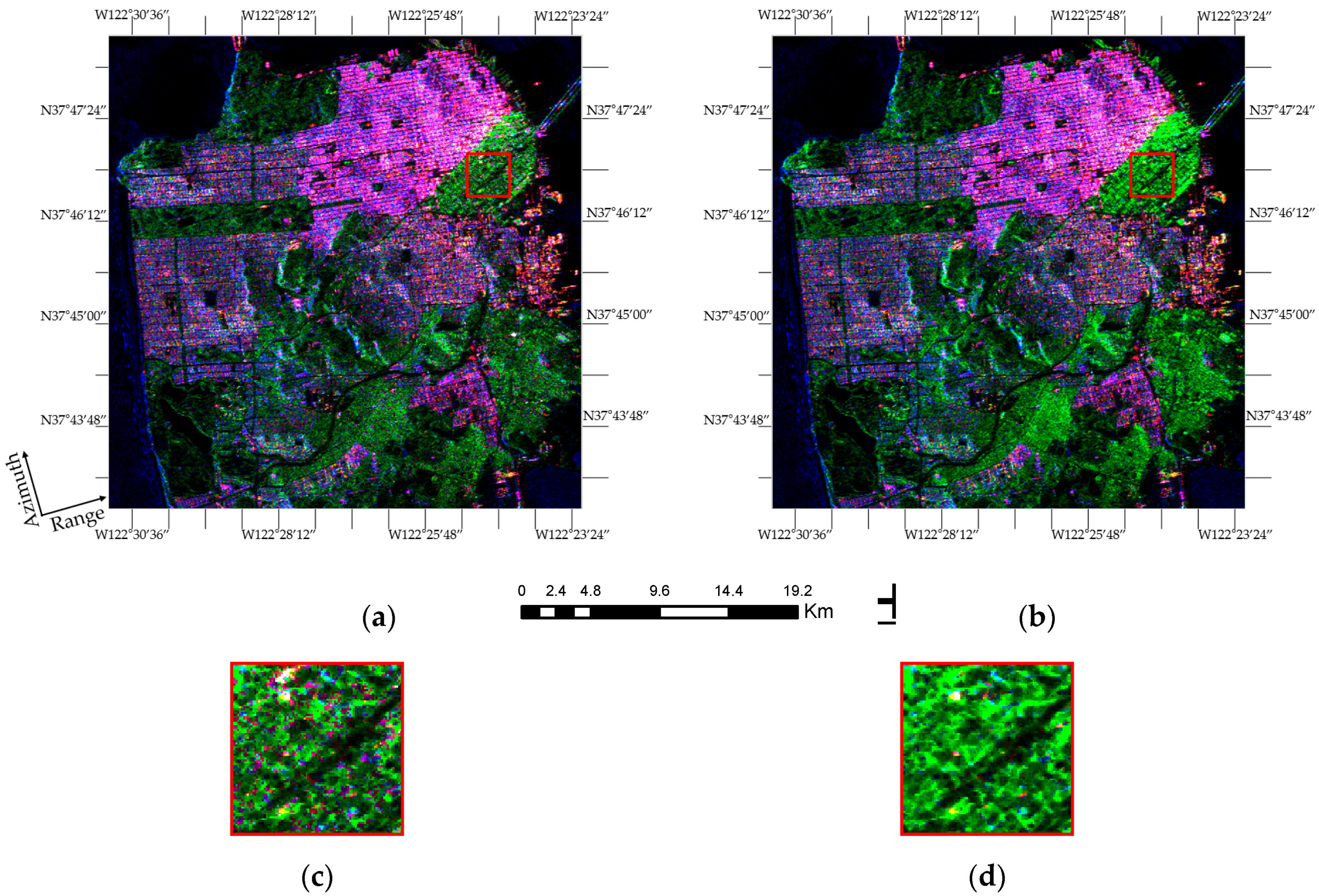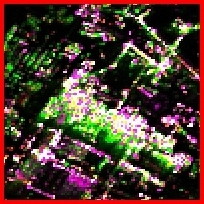An Improved Algorithm to Delineate Urban Targets with Model-Based Decomposition of PolSAR Data
Abstract
:1. Introduction
2. Methodology
2.1. Coherency Matrix [T] and Correlation Coefficient r
2.2. The Addition of a Volumetric Model for Urban Targets with Large AOAs and the Proposed Algorithm
- (i)
- Previous studies in the PolSAR data analysis and canopy backscattering modeling (e.g., [24,25,26]) suggest that |SHH|2 is usually greater than |SVV|2 in flooded forests or coniferous forest stands where strong double-bounced scattering caused by trunk-ground interactions exists. This relationship is especially true when the radar wavelength is long such as with an L-band sensor [24,25,26]. Thus, to make this mitigation and proposed algorithm applicable to PolSAR data when acquired at a long radar wavelength, and from areas consisting of urban targets, flooded forests, and coniferous forest stands, we compare |SHH|2 and |SVV|2. If |SHH|2 > |SVV|2, then [T]vol_Yamaguchi-2005 is used.
- (ii)
- The Yamaguchi-2005 algorithm can effectively decompose/classify the surface, urban targets with 0° or small AOAs, and forested areas. Thus, if the double-bounced scattering or surface scattering of an image pixel is more than 50%, then [T]vol_Yamaguchi-2005 is employed.
- (iii)
- Otherwise, [T]vol_4th is used.
3. Results and Discussion
3.1. Correlation Coefficient r
3.2. Validation of the Algorithm Using Goldstone Polarimetric Data
3.3. Decomposition of Oberpfaffenhofen Polarimetric Data
3.4. Applicability of the Algorithm to Two Additional PolSAR Datasets
3.5. Computational Efficiency
4. Conclusions
Supplementary Materials
Supplementary File 1Acknowledgments
Author Contributions
Conflicts of Interest
References
- Du, A.; Wang, Y. Compensation for Azimuth Angle or Scale Effect on Building Extraction in Urban Using SAR Scales of Polarization and Coherence. IEEE J. Sel. Top. Appl. Earth Obs. Remote Sens. 2016, 9, 2601–2610. [Google Scholar] [CrossRef]
- Iribe, K.; Sato, M. Analysis of Polarization Azimuth Angle Shifts by Artificial Structures. IEEE Trans. Geosci. Remote Sens. 2007, 45, 3417–3425. [Google Scholar] [CrossRef]
- Chen, S.W.; Ohki, M.; Shimada, M.; Sato, M. Deorientation Effect Investigation for Model-Based Decomposition over Oriented Built-Up Areas. IEEE Geosci. Remote Sens. Lett. 2013, 10, 273–277. [Google Scholar] [CrossRef]
- Lee, J.S.; Ainsworth, T.L. The Effect of Azimuth Angle Compensation on Coherency Matrix and Polarimetric Target Decompositions. IEEE Trans. Geosci. Remote Sens. 2011, 49, 53–64. [Google Scholar] [CrossRef]
- Yamaguchi, Y.; Sato, A.; Boerner, W.M.; Sato, R.; Yamada, H. Four-Component Scattering Power Decomposition With Rotation of Coherency Matrix. IEEE Trans. Geosci. Remote Sens. 2011, 49, 2251–2258. [Google Scholar] [CrossRef]
- Wang, Y.; Davis, F.W. Decomposition of Polarimetric Synthetic Aperture Radar Backscatter from Upland and Flooded Forests. Int. J. Remote Sens. 1997, 18, 1319–1332. [Google Scholar] [CrossRef]
- Van Zyl, J.J.; Arii, M.; Kim, Y. Model-Based Decomposition of Polarimetric SAR Covariance Matrices Constrained for Nonnegative Eigenvalues. IEEE Trans. Geosci. Remote Sens. 2011, 49, 3452–3459. [Google Scholar] [CrossRef]
- Freeman, A.; Durden, S.L. A Three-Component Scattering Model for Polarimetric SAR Data. IEEE Trans. Geosci. Remote Sens. 1998, 36, 963–973. [Google Scholar] [CrossRef]
- Freeman, A. Fitting a Two-Component Scattering Model to Polarimetric SAR Data from Forests. IEEE Trans. Geosci. Remote Sens. 2007, 45, 2583–2592. [Google Scholar] [CrossRef]
- Yamaguchi, Y.; Moriyama, T.; Ishido, M. Four Component Scattering Model for Polarimetry SAR Image Decomposition. IEEE Trans. Geosci. Remote Sens. 2005, 43, 1699–1706. [Google Scholar] [CrossRef]
- An, W.; Cui, Y.; Yang, J. Three-Component Model-Based Decomposition for Polarimetric SAR Data. IEEE Trans. Geosci. Remote Sens. 2010, 48, 2732–2739. [Google Scholar]
- Arii, M.; van Zyl, J.J.; Kim, Y. A General Characterization for Polarimetric Scattering from Vegetation Canopies. IEEE Trans. Geosci. Remote Sens. 2010, 48, 3349–3357. [Google Scholar] [CrossRef]
- Antropov, O.; Rauste, Y.; Häme, T. Volume Scattering Modeling in PolSAR Decompositions: Study of ALOS PALSAR Data over Boreal Forest. IEEE Trans. Geosci. Remote Sens. 2011, 49, 3838–3848. [Google Scholar] [CrossRef]
- Huang, X.; Wang, J.; Shang, J. An Integrated Surface Parameter Inversion Scheme over Agricultural Fields at Early Growing Stages by Means of C-Band Polarimetric RADARSAT-2 Imagery. IEEE Trans. Geosci. Remote Sens. 2016, 54, 2510–2528. [Google Scholar] [CrossRef]
- Chen, S.W.; Wang, X.S.; Xiao, S.P.; Sato, M. General Polarimetric Model-Based Decomposition for Coherency Matrix. IEEE Trans. Geosci. Remote Sens. 2014, 52, 1843–1855. [Google Scholar] [CrossRef]
- Hong, S.H.; Wdowinski, S. Double-Bounce Component in Cross-Polarimetric SAR from a New Scattering Target Decomposition. IEEE Trans. Geosci. Remote Sens. 2014, 52, 3039–3051. [Google Scholar] [CrossRef]
- Xiang, D.; Ban, Y.; Su, Y. Model-Based Decomposition With Cross Scattering for Polarimetric SAR Urban Areas. IEEE Geosci. Remote Sens. Lett. 2015, 12, 2496–2500. [Google Scholar] [CrossRef]
- Xie, Q.; Ballester-Berman, J.D.; Lopez-Sanchez, J.M.; Zhu, J.; Wang, C. On the Use of Generalized Volume Scattering Models for the Improvement of General Polarimetric Model-Based Decomposition. Remote Sens. 2017, 9, 117. [Google Scholar] [CrossRef]
- Kajimoto, M.; Susaki, J. Urban-Area Extraction from Polarimetric SAR Images Using Polarization Orientation Angle. IEEE Trans. Geosci. Remote Sens. Lett. 2013, 10, 337–341. [Google Scholar] [CrossRef] [Green Version]
- Susaki, J.; Kishimoto, M. Urban Area Extraction Using X-Band Fully Polarimetric SAR Imagery. IEEE J. Sel. Top. Appl. Earth Obs. Remote Sens. 2016, 9, 2592–2601. [Google Scholar] [CrossRef]
- Azmedroub, B.; Ouarzeddine, M.; Souissi, B. Extraction of Urban Areas from Polarimetric SAR Imagery. IEEE J. Sel. Top. Appl. Earth Obs. Remote Sens. 2016, 9, 2583–2591. [Google Scholar] [CrossRef]
- Zou, B.; Lu, D.; Zhang, L.; Moon, W.M. Eigen-Decomposition-Based Four-Component Decomposition for PolSAR Data. IEEE J. Sel. Top. Appl. Earth Obs. Remote Sens. 2016, 9, 1286–1296. [Google Scholar] [CrossRef]
- Chen, S.W.; Wang, X.S.; Li, Y.Z.; Sato, M. Adaptive Model-Based Polarimetric Decomposition Using PolInSAR Coherence. IEEE Trans. Geosci. Remote Sens. 2014, 52, 1705–1718. [Google Scholar] [CrossRef]
- Hess, L.L.; Melack, J.M.; Filoso, S.; Wang, Y. Delineation of Inundated Area and Vegetation along the Amazon Floodplain with the SIR-C Synthetic Aperture Radar. IEEE Trans. Geosci. Remote Sens. 1995, 33, 896–904. [Google Scholar] [CrossRef]
- Wang, Y.; Hess, L.L.; Filoso, S.; Melack, J.M. Understanding the Radar Backscatter from Flooded and Nonflooded Amazonian Forests: Results from Canopy Backscatter Modeling. Remote Sens. Environ. 1995, 54, 324–332. [Google Scholar] [CrossRef]
- Wang, Y.; Davis, F.W.; Melack, J.M.; Kasischke, E.S.; Christensen, N.L., Jr. The Effects of Changes in Forest Biomass on Radar Backscatter from Tree Canopies. Int. J. Remote Sens. 1995, 16, 503–513. [Google Scholar] [CrossRef]
- Freeman, A.; Shen, Y.; Werner, C.L. Polarimetric SAR Calibration Experiment Using Active Radar Calibrator. IEEE Trans. Geosci. Remote Sens. 1990, 28, 224–240. [Google Scholar] [CrossRef]









| Algorithm | Decomposition Approach | Primary Usage | Secondary Usage | Note |
|---|---|---|---|---|
| Du and Wang [1], and Chen et al. [23]. | Model component and coherence | Urban area | Forested environment | [1] is revised from [10]. [23] is revised from [8]. |
| Wang and Davis [6], van Zyl et al. [7], and Zou et al. [22]. | Eigenvalue and eigenvector | Forested environment | Urban area | |
| Yamaguchi et al. [5], Freeman and Durden [8], Freeman [9], Yamaguchi et al. [10], An et al. [11], Arii et al. [12], Antropov et al. [13], Huang et al. [14], Chen et al. [15], Hong and Wdowinski [16], Xiang et al. [17], and Xie et al. [18]. | Model component | Forested environment | Urban area | [5] is revised from [10]. [9] is a simplified version of [8]. [10] and [11] are revised from [8]. [13] is the generalization form of [8], [9], [10], and [11]. [14] is simplified from [12]. [15] uses four volumetric scattering models in [8], [10], and [11]. [16] and [17] are revised from [10]. [18] is a combination of [13], [14] and [15]. |
| Kajimoto and Susaki [19], Susaki and Kajimoto [20], and Azmedroub et al. [21]. | Model component and classification | Urban area | Forested environment | [19,20,21] are hybrid of decomposition and classification. |
| The proposed algorithm. | Model component | Urban area | This is a revised version of [10]. |
| CR | 1 | 2 | 3 | 4 | 5 | 6 | 7 | 8 | 9 |
|---|---|---|---|---|---|---|---|---|---|
| Surface scattering | 98.1 | 98.7 | 99.8 | 0.2 | 0.6 | 0.3 | 0.8 | 9.5 | 4.5 |
| 98.1 | 98.6 | 99.8 | 0.5 | 0.6 | 0.6 | 2.8 | 3.2 | 1.5 | |
| 0.0 | 0.1 | 0.0 | −0.3 | 0.0 | −0.3 | −2.0 | 6.3 | 3.0 | |
| Double-bounced scattering | 1.8 | 0.3 | 0.2 | 96.1 | 99.3 | 98.3 | 72.1 | 64.1 | 53.6 |
| 1.8 | 0.3 | 0.2 | 99.3 | 99.4 | 98.0 | 6.0 | 14.2 | 0.3 | |
| 0.0 | 0.0 | 0.0 | −3.2 | −0.1 | 0.3 | 66.1 | 49.9 | 53.3 | |
| Volumetric scattering | 0.1 | 1.0 | 0.0 | 3.7 | 0.1 | 1.4 | 27.1 | 26.4 | 41.9 |
| 0.1 | 1.1 | 0.0 | 0.2 | 0.0 | 1.4 | 91.2 | 82.6 | 98.2 | |
| 0.0 | −0.1 | 0.0 | 3.5 | 0.1 | 0.0 | −64.1 | −56.2 | −56.3 |
| Ps/(Ps + Pd + Pv) | Pd/(Ps + Pd + Pv) | Pv/(Ps + Pd + Pv) | |||||||
|---|---|---|---|---|---|---|---|---|---|
| α | β | δ | α | β | δ | α | β | δ | |
| Red square | 32.2 | 31.2 | 1.0 | 59.0 | 57.7 | 1.1 | 8.8 | 11.1 | −2.3 |
| Green square | 27.2 | 26.9 | 0.3 | 27.1 | 26.8 | 0.3 | 45.7 | 46.2 | −0.5 |
| Blue square | 37.9 | 25.7 | 12.2 | 44.7 | 31.3 | 13.4 | 17.4 | 43.0 | −25.6 |
| 200 × 200 | 400 × 400 | 800 × 800 | 1600 × 1600 | |
|---|---|---|---|---|
| The proposed algorithm | 0.9 | 2.6 | 10.6 | 51.2 |
| Yamaguchi-2011 algorithm | 1.7 | 15.4 | 222.4 | 4133.4 |
| Xie et al. algorithm | 6699.8 | 26,500.0 | 102,170.0 | - a |
© 2017 by the authors. Licensee MDPI, Basel, Switzerland. This article is an open access article distributed under the terms and conditions of the Creative Commons Attribution (CC BY) license (http://creativecommons.org/licenses/by/4.0/).
Share and Cite
Duan, D.; Wang, Y. An Improved Algorithm to Delineate Urban Targets with Model-Based Decomposition of PolSAR Data. Remote Sens. 2017, 9, 1037. https://doi.org/10.3390/rs9101037
Duan D, Wang Y. An Improved Algorithm to Delineate Urban Targets with Model-Based Decomposition of PolSAR Data. Remote Sensing. 2017; 9(10):1037. https://doi.org/10.3390/rs9101037
Chicago/Turabian StyleDuan, Dingfeng, and Yong Wang. 2017. "An Improved Algorithm to Delineate Urban Targets with Model-Based Decomposition of PolSAR Data" Remote Sensing 9, no. 10: 1037. https://doi.org/10.3390/rs9101037





